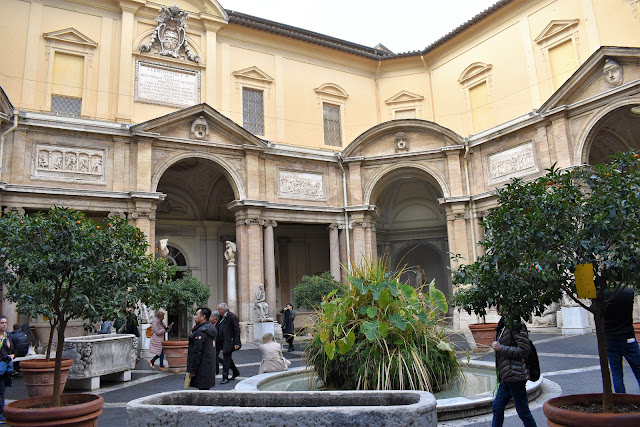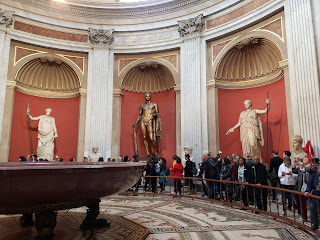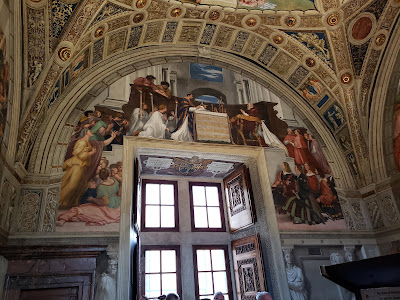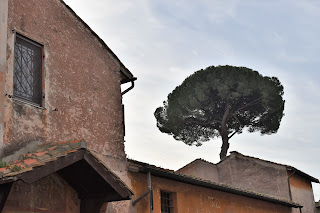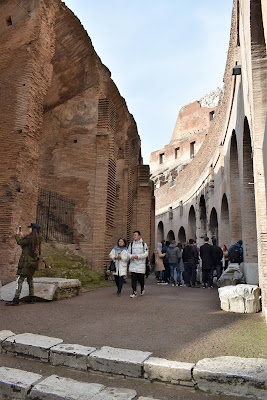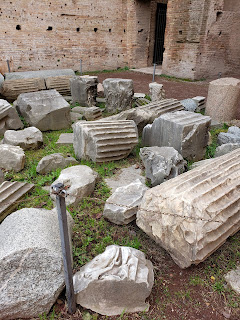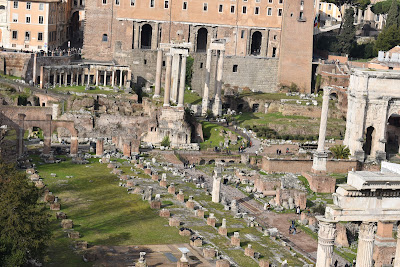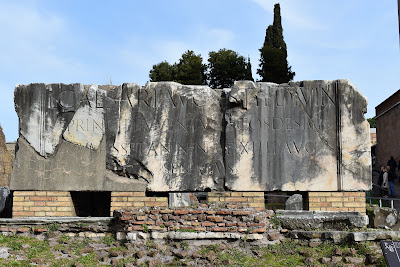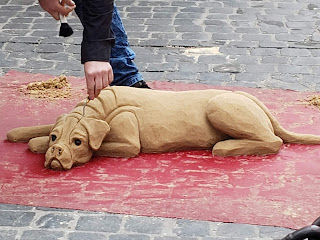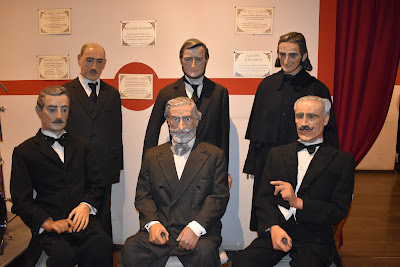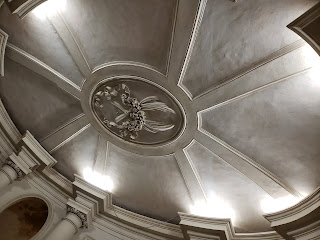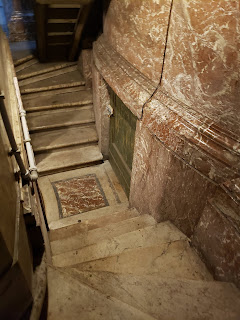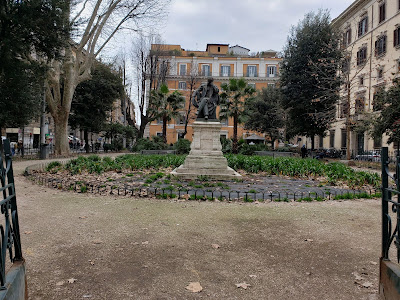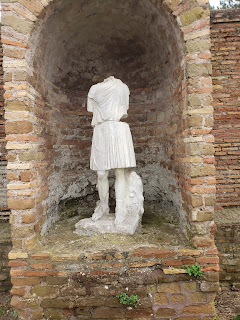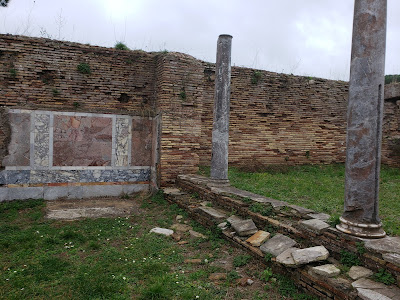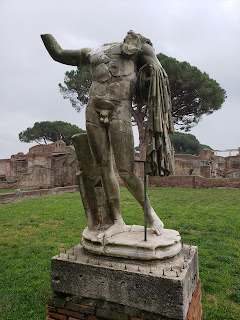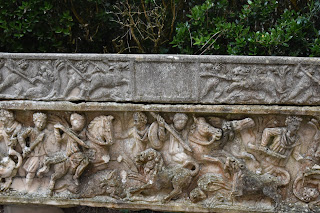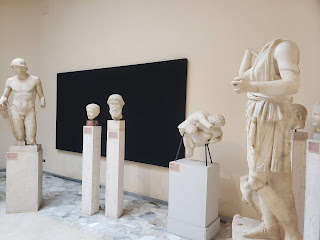Sunday, March 15, 2020
Rome Italy
Rome Italy
As I post these pictures I feel so very fortunate that Scott and I were able to visit before the pandemic hit. I see now on tv the reporters in Rome all the streets empty and shops closed. It was crowded while we were there.
Blessed to have gone and gotten back before this got bad.
January 25 - February 1, 2020
1st Day we had a bit of rain and cool weather. Our flight got us in at 7am so we had the entire Saturday to check out the city.
Although we look pretty tired in these pictures so don't judge!
Although we look pretty tired in these pictures so don't judge!
Inside a Church
Me chatting with a war vet
The Flooring was crazy designs
Walking around town
Pincian Hill
Large Green Door to this end of the city
Surprising amount of Palm Trees in Rome
Castel Sant'Angelo
Eggplant, Pepper and Zucchini Pizza
Vatican Museums
There is no photography in the Sistine chapel , but throughout the building and museums we took plenty of photos.
No part of the Vatican that isn't decorated
Floor to Ceilings all so breathtaking
Floors were amazing
Some of these pictures are a bit out of order
Scott and I were both taking pictures and I'm using some of each
Floor mosaics are amazing and so detailed the tile parts are about as big as a fingernail
Everywhere you looked was art many on the ceilings
A ceiling above and below photos
tile floors
Ceiling had pine cone art
Yet another ceiling ...the colors were so vibrant
chest of drawers
Beautiful Tapestries on the walls
The Vatican Museums are the public art and sculpture museums in the Vatican City. They display works from the immense collection amassed by popes throughout the centuries including several of the most renowned Roman sculptures and most important masterpieces of Renaissance art in the world. The museums contain roughly 70,000 works, of which 20,000 are on display, and currently employ 640 people who work in 40 different administrative, scholarly, and restoration departments. Pope Julius II founded the museums in the early 16th century. The Sistine Chapel with its ceiling decorated by Michelangelo and the Stanze di Raffaello decorated by Raphael are on the visitor route through the Vatican Museums. In 2017, they were visited by six million people, which combined makes them the 4th most visited art museum in the world. They are one of the largest museums in the world. There are 54 galleries, or sale, in total, with the Sistine Chapel, notably, being the very last sala within the Museum.
The Sistine Chapel is a chapel in the Apostolic Palace, the official residence of the pope, in Vatican City. Originally known as the Cappella Magna, the chapel takes its name from Pope Sixtus IV, who restored it between 1473 and 1481. Since that time, the chapel has served as a place of both religious and functionary papal activity. Today, it is the site of the papal conclave, the process by which a new pope is selected. The fame of the Sistine Chapel lies mainly in the frescos that decorate the interior, most particularly the Sistine Chapel ceiling and The Last Judgment by Michelangelo. During the reign of Sixtus IV, a team of Renaissance painters that included Sandro Botticelli, Pietro Perugino, Pinturicchio, Domenico Ghirlandaio and Cosimo Rosselli, created a series of frescos depicting the Life of Moses and the Life of Christ, offset by papal portraits above and trompe-l'œil drapery below. These paintings were completed in 1482, and on 15 August 1483 Sixtus IV celebrated the first mass in the Sistine Chapel for the Feast of the Assumption, at which ceremony the chapel was consecrated and dedicated to the Virgin Mary
Even the Stairway out of the building was ART!
Day 2
Colosseum
Your Feet get a workout not sure how they managed back in the day!
Guess who in the jeans and black backpack...ha!
Oh we look tired!
The Arch of Constantine is a triumphal arch in Rome dedicated to the emperor Constantine the Great. The arch was commissioned by the Roman Senate to commemorate Constantine’s victory over Maxentius at the Battle of Milvian Bridge in AD 312. Situated between the Colosseum and the Palatine Hill, the arch spans the Via triumphalis, the route taken by victorious military leaders when they entered the city in a triumphal procession. Dedicated in 315, it is the largest Roman triumphal arch, with overall dimensions of.21 m high, 25.9 m wide and 7.4 m deep. It has three bays, the central one being 11.5 m high and 6.5 m wide and the laterals 7.4 m by 3.4 m each. The arch is constructed of brick-faced concrete reveted in marble. The three bay design with detached columns was first used for the Arch of Septimius Severus in the Roman Forum and repeated in several other arches now lost. Though dedicated to Constantine, much of the sculptural decoration consists of reliefs and statues removed from earlier triumphal monuments dedicated to Trajan, Hadrian and Marcus Aurelius
.
.
Inside the Colosseum
The Colosseum or Coliseum, also known as the Flavian Amphitheatre, is an oval amphitheatre in the centre of the city of Rome, Italy. Built of travertine limestone, tuff, and brick-faced concrete, it was the largest amphitheatre ever built at the time and held 50,000 to 80,000 spectators. The Colosseum is situated just east of the Roman Forum. Construction began under the emperor Vespasian in AD 72 and was completed in AD 80 under his successor and heir, Titus. Further modifications were made during the reign of Domitian. These three emperors are known as the Flavian dynasty, and the amphitheatre was named in Latin for its association with their family name. The Colosseum could hold an estimated 50,000 to 80,000 spectators at various points of its history over the centuries, having an average audience of some 65,000; it was used for gladiatorial contests and public spectacles such as mock sea battles, animal hunts, executions, re-enactments of famous battles, and dramas based on Classical mythology. The building ceased to be used for entertainment in the early medieval era.
LOTS of Stairs!
Palatino Areas and Monuments
The Palatine is the most famous of Rome's seven hills. In Ancient Rome it was considered one of the most desirable neighborhood in the city, and was the home of aristocrats and emperors. It was also believed to be the location of the Lupercal (the cave where Romulus and Remus were found by the she-wolf).
The Palatine Hill, which is the centre most of the Seven Hills of Rome, is one of the most ancient parts of the city and has been called "the first nucleus of the Roman Empire."[1] It stands 40 metres above the Roman Forum, looking down upon it on one side, and upon the Circus Maximus on the other. From the time of Augustus Imperial palaces were built here. Prior to extensions to the Palace of Tiberius and the construction of the Domus Augustana by Domitian, 81-96 AD, the hill was mostly occupied by the houses of the rich. The perimeter measures 2,182 metres and the area is 255,801 square metres with a circumference of 1,740 metres while the Regionary Catalogues of the fourth century give a perimeter of 11,510 feet equals 131 acres
So needless to say it was lot of walking, hill areas and sites to see.
Pillars like this are sort of all over the city in random places where they have been dug up. It's very strange to think they just leave them out in the elements.
Roman Forum
The Roman Forum, also known by its Latin name Forum Romanum, is a rectangular forum surrounded by the ruins of several important ancient government buildings at the center of the city of Rome. Citizens of the ancient city referred to this space, originally a marketplace, as the Forum Magnum, or simply the Forum. For centuries the Forum was the center of day-to-day life in Rome: the site of triumphal processions and elections; the venue for public speeches, criminal trials, and gladiatorial matches; and the nucleus of commercial affairs. Here statues and monuments commemorated the city's great men. The teeming heart of ancient Rome, it has been called the most celebrated meeting place in the world, and in all history. Located in the small valley between the Palatine and Capitoline Hills, the Forum today is a sprawling ruin of architectural fragments and intermittent archaeological excavations attracting 4.5 million or more sightseers yearly. Many of the oldest and most important structures of the ancient city were located on or near the Forum. The Roman Kingdom's earliest shrines and temples were located on the southeastern edge.
Looking down at this area is a glimpse of how they lived ...churches, shows, races, streets, shops
Below picture you can see people on the top of that rounded structure...that's where we were taking some of those areal photos
Shocking to think the paintings, marble, stone and walls are still there after all this time.
Come out of the gates and then this is the street.
Many street prefomers and views everywhere you turn.
You feel like your in a movie scene.
Alter of the Fatherland
aka Wedding Cake
The Victor Emmanuel II National Monument or Vittoriano, improperly called Altare della Patria, is a national monument built in honor of Victor Emmanuel II, the first king of a unified Italy, located in Rome, Italy. It occupies a site between the Piazza Venezia and the Capitoline Hill. It is currently managed by the Polo Museale del Lazio and is owned by the Ministry of Cultural Heritage and Activities. From an architectural point of view it was conceived as a modern forum, an agora on three levels connected by stairways and dominated by a portico characterized by a colonnade. The complex process of national unity and liberation from foreign domination carried out by King Victor Emmanuel II of Savoy, to whom the monument is dedicated, has a great symbolic and representative value, being architecturally and artistically centered on the Italian unification: for this reason the Vittoriano is considered one of the national symbols of Italy. It also preserves the Altar of the Fatherland, first an altar of the goddess Rome and then also a shrine of the Italian Unknown Soldier, thus adopting the function of a lay temple consecrated to Italy.
Parthenon
The Pantheon is a former Roman temple, now a Catholic church, in Rome, Italy, on the site of an earlier temple commissioned by Marcus Agrippa during the reign of Augustus. It was completed by the emperor Hadrian and probably dedicated about 126 AD. Its date of construction is uncertain, because Hadrian chose not to inscribe the new temple but rather to retain the inscription of Agrippa's older temple, which had burned down. The building is cylindrical with a portico of large granite Corinthian columns under a pediment. A rectangular vestibule links the porch to the rotunda, which is under a coffered concrete dome, with a central opening to the sky. Almost two thousand years after it was built, the Pantheon's dome is still the world's largest unreinforced concrete dome. The height to the oculus and the diameter of the interior circle are the same, 43 metres. It is one of the best-preserved of all Ancient Roman buildings, in large part because it has been in continuous use throughout its history and, since the 7th century, the Pantheon has been in use as a church dedicated to "St. Mary and the Martyrs" but informally known as "Santa Maria Rotonda".
Piazza Navona Fountain
Fountain of Neptune
Sand Art
Spanish Steps
Many McDonald's in Rome bonus is they have a free bathroom!
I went to this fountain a lot and it was always packed
Trevi Fountain
The Trevi Fountain is a fountain in the Trevi district in Rome, Italy, designed by Italian architect Nicola Salvi and completed by Giuseppe Pannini and several others. Standing 26.3 metres high and 49.15 metres wide, it is the largest Baroque fountain in the city and one of the most famous fountains in the world.
A museum that is under the Trevi Fountain
Metro was how I traveled everyday
Circus Maximus
The Circus Maximus is an ancient Roman chariot-racing stadium and mass entertainment venue located in Rome, Italy. Situated in the valley between the Aventine and Palatine Hills, it was the first and largest stadium in ancient Rome and its later Empire. It measured 621 m in length and 118 m in width and could accommodate over 150,000 spectators. In its fully developed form, it became the model for circuses throughout the Roman Empire. The site is now a public park.
Pyramid of Caius Cestius
The Pyramid of Cestius is an ancient pyramid in Rome, Italy, near the Porta San Paolo and the Protestant Cemetery. It was built as a tomb for Gaius Cestius, a member of the Epulones religious corporation. It stands at a fork between two ancient roads, the Via Ostiensis and another road that ran west to the Tiber along the approximate line of the modern Via Marmorata. Due to its incorporation into the city's fortifications, it is today one of the best-preserved ancient buildings in Rome
Rush Hour on Subway...we had to wait for 2nd train
Coluseem at Night
Gnocchi and Veggie Lasagna
Day 4
I took a LONG bus ride to edge of town to see these ruins of a home while Scott was working.
Villa Die Quintili
The Villa dei Quintili was built around 150 A.D. and was once the largest residential building outside the city of Rome. Originally it belonged to Sextus Quintilius Valerius Maximus and his brother Sextus Quintilius Condianus, consuls from the year 151. After Emperor Commodus had the brothers executed under the pretext of a planned conspiracy, the villa became his property in 182. From there he made it his residence and extended the building.
There was a small building with statues and parts of statues that have been recently recovered from the property. They continue to dig and find new items and parts of the complex
This was bigger than me
I met a older gentleman from Las Vegas
We were the only 2 people walking around
He seemed to know a LOT of Italian history so I let him be my guide
LONG walk up the hill
Mike walked into my pic lower left...ha!
This building was on the property, but was sold off to someone and they had put in real windows and electricity I think it was a museum, but not part of my ticket.
Underground tunnel that the servants would move items from one side of the complex to the other
This room here was GRAND looked like a massive entrance or dance area it had seats on the sides of the room. Flooring was awesome.
Crazy to imagine the hallways of this grand home being this wide..it was approximately 15 feet
Some of the flooring still in tact
Day 5
Left my Camera at hotel
Day 6
Me wandering the streets taking photos and getting turned around
The detail on this pillar is unbelievable it goes all the way up and is about 15 feet tall!
Very weird and cheesy Wax Museum
This looks more like a Saturday Night Live Alec Baldwin playing Trump
Campidoglio Square
Open Market
Avocado place was closed...ugh
Hummus place was closed...ugh
Heading back to hotel
Places to eat typically were not open until 730pm for dinner, but we found a GREAT place only one metro stop away from our hotel we ended up having dinner there twice. Lovely Wine too!
There was a Pizza Place Gege walking distance to our hotel so some nights (maybe 3) we just were too tired to head out on subway to explore plus places were not open for dinner until 730pm. So we got pizza from there. It was all square and they would cut it with big scissors and weigh it for cost. They had SO many vegetarian options. It was very yummy!
Day 7
St. Peter's Basilica
The Papal Basilica of Saint Peter in the Vatican, or simply Saint Peter's Basilica, is a church built in the Renaissance style located in Vatican City, the papal enclave which is within the city of Rome. Designed principally by Donato Bramante, Michelangelo, Carlo Maderno and Gian Lorenzo Bernini, St. Peter's is the most renowned work of Renaissance architecture and the largest church in the world. While it is neither the mother church of the Catholic Church nor the cathedral of the Diocese of Rome, St. Peter's is regarded as one of the holiest Catholic shrines. It has been described as "holding a unique position in the Christian world" and as "the greatest of all churches of Christendom". Catholic tradition holds that the basilica is the burial site of Saint Peter, chief among Jesus's apostles and also the first Bishop of Rome. Saint Peter's tomb is supposedly directly below the high altar of the basilica. For this reason, many popes have been interred at St. Peter's since the Early Christian period. A church has stood on this site since the time of the Roman emperor Constantine the Great. Old St. Peter's Basilica dates from the 4th century AD.
The security line looks worse than you think only 30 minutes
Nativity Scene was still up inside the Church
You can see me below...everything was just massive!!!
Pope's Royal Guards
The Pontifical Swiss Guard (also Papal Swiss Guard or simply Swiss Guard; Latin: Pontificia Cohors Helvetica;[2] Italian: Guardia Svizzera Pontificia; German: Päpstliche Schweizergarde; French: Garde suisse pontificale) is a minor armed forces and honour guards unit maintained by the Holy See that protects the Pope and the Apostolic Palace, serving as the de facto military of Vatican City. Established in 1506 under Pope Julius II, the Pontifical Swiss Guard is among the oldest military units in continuous operation.
The dress uniform is of blue, red, orange and yellow with a distinctly Renaissance appearance. The modern guard has the role of bodyguard of the Pope. The Swiss Guard are equipped with traditional weapons, such as the halberd, as well as with modern firearms. Since the failed assassination attempt on Pope John Paul II in 1981, a much stronger emphasis has been placed on the Guard's non-ceremonial roles, and has seen enhanced training in unarmed combat and small arms.
Recruits to the guards must be unmarried Swiss Catholic males between 19 and 30 years of age who have completed basic training with the Swiss Armed Forces.
Basilica of St. John the Baptist
Lovely forgotten Church
The Cathedral Saints John the Baptist and the Evangelist in the Lateran – also known as the Papal Archbasilica of Saint John [in] Lateran, Saint John Lateran, or the Lateran Basilica – is the cathedral church of the Diocese of Rome in the city of Rome and serves as the seat of the Roman Pontiff.
It is the oldest and highest ranking of the four papal major basilicas, holding the unique title of "archbasilica". It is the oldest public church in the city of Rome, and the oldest basilica of the Western world. It houses the cathedra of the Roman bishop, and has the title of ecumenical mother church of the Catholic faithful.
It has a hidden stairwell
underground
Back to the streets of the City
The Basilica Ulpia was an ancient Roman civic building located in the Forum of Trajan. The Basilica Ulpia separates the temple from the main courtyard in the Forum of Trajan with the Trajan's Column to the northwest. It was named after Roman emperor Trajan whose full name was Marcus Ulpius Traianus. It became perhaps the most important basilica after two ancient ones, the Basilicas Aemilia and Julia. With its construction, much of the political life moved from the Roman Forum to the Forum of Trajan. It remained so until the construction of the Basilica of Maxentius and Constantine. Unlike later Christian basilicas, it had no known religious function; it was dedicated to the administration of justice, commerce and the presence of the emperor. It was the largest in Rome measuring 117 by 55 meters. The Basilica Ulpia was composed of a great central nave with four side aisles with clerestory windows to let light into the space divided by rows of columns and two semicircular apses, one at each of the ends with the entry to the basilica located on the longitudinal side. The columns and the walls were of precious marbles; the 50 meter high roof was covered by gilded bronze tiles.
Back at the Wedding Cake Building new Guards last time it was women this time it's men
View from the Top of the 'cake'
Vegan Gelato
Chocolate Peanut Butter and Strawberry
Day 8 Final Day
Ostia Antica
Ostia Antica is a large archaeological site, close to the modern town of Ostia, that is the location of the harbour city of ancient Rome, 15 miles southwest of Rome. "Ostia" the Latin word for "mouth". At the mouth of the River Tiber, Ostia was Rome's seaport, but due to silting the site now lies 2 miles from the sea. The site is noted for the excellent preservation of its ancient buildings, magnificent frescoes and impressive mosaics.
Hard to imagine all the detail on EVERYTHING all over the city so many years ago. Seems so glorious!
This would be the front entrance of the store were you bought wheat
Random items they dug up and a whole city it's just crazy!
Public Toilet back in the day they all came together and talked while they did their business
This table and mosaic still intact
Bunches of Pillars
These are paintings they covered in glass to protect
Mosaics all over the ground
2nd Century AD
Pots they would put products to sell in and keep cool in the ground
The Ostiense Museum
They have some preserved pieces that were dug up on the site
Tyrrhenian Sea
Ostia
February 2nd, 2020
Time to finally head back home
Home Sweet Florida
Picture from airplane window




































